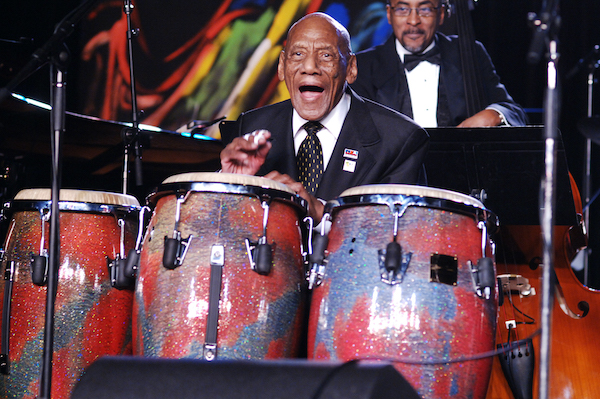Oct 28, 2025 10:47 AM
In Memoriam: Jack DeJohnette, 1942–2025
Jack DeJohnette, a bold and resourceful drummer and NEA Jazz Master who forged a unique vocabulary on the kit over his…

Cándido (1921–2020), shown performing in 2008
(Photo: Tom Pich/National Endowment for the Arts)Cándido Camero, an NEA Jazz Master who was regarded as the father of modern conga drumming, died Nov. 7 in New York. He was 99.
“Cándido,” as he was known by jazz aficionados, pioneered the use of multiple conga-type drums, first incorporating the slightly smaller quinto into his setup and finally settling on a three-drum arrangement that also included the larger tumba. He quickly mastered a technique of playing all three simultaneously and developed a method of tuning the drums to different pitches to create simple melodies and chords.
Born April 22, 1921, in Havana, Cándido began playing homemade bongos at age 4. He went on to learn flute, upright bass and tres, all of which he played while backing Cuban music stars in Havana nightclubs during the 1930s and 1940s, including the famous Cabaret Tropicana, where he performed with Mongo Santamaría. He made the switch to congas in the early 1940s.
Cándido first came to the United States in 1946 and settled in New York permanently starting in 1952. In addition to playing with American dance orchestras, he worked with jazz pianist Billy Taylor for a year at New York’s Downbeat club, where he devised methods to apply Cuban rhythms to American swing and bebop, helping to lay the groundwork for a historic crossover movement between American jazz artists and Cuban musicians that continues to this day.
Cándido toured and recorded with some of the biggest names in jazz and Latin music, including Tito Puente, Machito, Duke Ellington, Charlie Parker, Miles Davis, Stan Kenton, Woody Herman, Lionel Hampton, Sonny Rollins, Wes Montgomery, Gerry Mulligan, Charles Mingus and Quincy Jones. He gained national exposure via TV appearances on The Ed Sullivan Show and The Jackie Gleason Show.
The conguero was known for clean living, a topic he liked to discuss in his old age. “I have never smoked, not even a Cuban cigar!” he said in the May 2017 issue of DownBeat. “I never drank alcohol, not even beer or wine, and I’ve never used stimulants for false inspirations. ... I may need help to get to my drums because of arthritis, and I may be approaching 100, but when I start to play, look out, because I feel like I’m 20 years old again!”
In addition to contributing to dozens of albums and film soundtracks, Cándido recorded multiple leader dates for various labels, including ABC-Paramount, Blue Note, Chesky, Tico and the dance-music record company Salsoul, which produced disco-era hits for him.
Cándido’s most recent release was 2014’s The Master (Chesky). He was the subject of Ivan Acosta’s acclaimed 2005 documentary, Cándido: Hands of Fire, and in 2009, he received a Latin Grammy Lifetime Achievement Award.
During his DownBeat interview, Cándido took a long perspective on the music he had played since childhood. “The music never changes,” he observed. “It’s never going to change because tradition never changes. Since I was born and listened to music, the only thing that is different is the arrangement. The foundation never changes.” DB
Updated Dec. 1

Jack DeJohnette boasted a musical resume that was as long as it was fearsome.
Oct 28, 2025 10:47 AM
Jack DeJohnette, a bold and resourceful drummer and NEA Jazz Master who forged a unique vocabulary on the kit over his…

D’Angelo achieved commercial and critical success experimenting with a fusion of jazz, funk, soul, R&B and hip-hop.
Oct 14, 2025 1:47 PM
D’Angelo, a Grammy-winning R&B and neo-soul singer, guitarist and pianist who exerted a profound influence on 21st…

Kandace Springs channeled Shirley Horn’s deliberate phrasing and sublime self-accompaniment during her set at this year’s Pittsburgh International Jazz Festival.
Sep 30, 2025 12:28 PM
Janis Burley, the Pittsburgh International Jazz Festival’s founder and artistic director, did not, as might be…

Jim McNeely’s singular body of work had a profound and lasting influence on many of today’s top jazz composers in the U.S. and in Europe.
Oct 7, 2025 3:40 PM
Pianist Jim McNeely, one of the most distinguished large ensemble jazz composers of his generation, died Sept. 26 at…

Drummond was cherished by generations of mainstream jazz listeners and bandleaders for his authoritative tonal presence, a defining quality of his style most apparent when he played his instrument unamplified.
Nov 4, 2025 11:39 AM
Ray Drummond, a first-call bassist who appeared on hundreds of albums as a sideman for some of the top names in jazz…